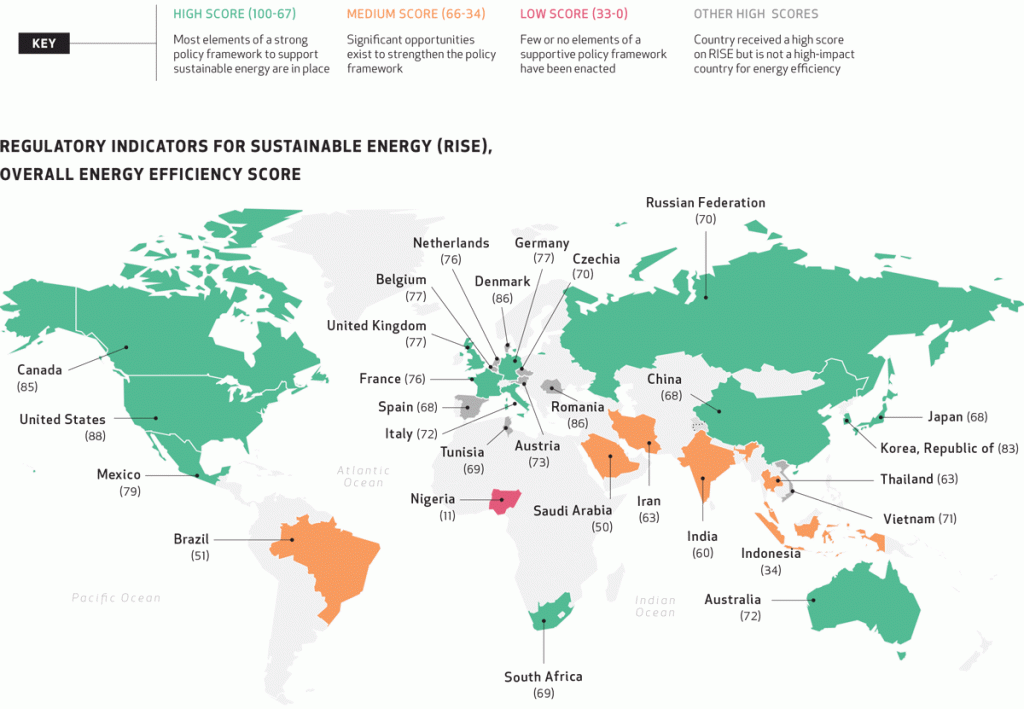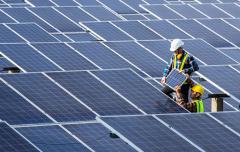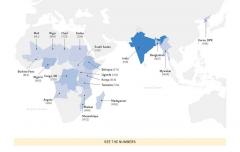Energy Efficiency: RISE Regulatory environment

Quick Facts
Context
- RISE offers policy makers and investors detailed country- level insights on the policy and regulatory environment for sustainable energy across 111 countries globally. It shines light on the need to attach greater political and policy priority to energy efficiency. Many countries have few or no policies in place to support energy efficiency.
- Energy security concerns among high income countries in the 1970s spurred efforts to address wasteful energy consumption. Most of those countries now have ambitious policies and incentivizing regulatory environments in place. Leading scorers among developing countries are in Central Asia, in compliance with ambition levels of the EU Energy Efficiency Directive.
- China started introducing energy efficiency measures in the 1980s to minimize energy imports as the economy expanded rapidly. Ambitious targets were set in its 12th Five Year Plan. TheThousandCompaniesEnergyConservationAction Plan mandates large energy users to conduct energy audits and report regularly. A mandatory labeling system covers products such as refrigerators, air conditioners, lighting equipment and industrial electric motors. Tax incentives, green bonds, and energy service contracts have been important drivers or consumers.
- RISE suggests an important role for utilities in meeting efficiency, as well as access, objectives because of utilities’ in-depth knowledge of electricity consumers’ habits and because of their own power consumption. Yet only half of RISE countries require their utilities to undertake energy efficiency measures. There is a clear correlation between scoring well on the utilities indicator and scoring well across the board on all other energy efficiency indicators.
- Since the 2011 Arab Spring, Egypt, Iran, Jordan, Morocco, and Tunisia have undertaken major energy subsidy reforms so as to reduce their fuel dependency and are beginning to let stronger price signals incentivize energy savings.
NOTES: 1. Regulatory Indicators for Sustainable Energy (RISE) is a suite of indicators that assesses the legal and regulatory environment for investment in sustainable energy. 2. The dotted line represents approximately the Line of Control in Jammu and Kashmir by India and Pakistan. The final status of Jammu and Kashmir has not yet been agreed upon by the parties. 3. This map was produced by SEforALL. It is based on the UN Map of the World, which can be found here: http://www.un.org/Depts/Cartographic/map/profile/world.pdf. The boundaries, colors, denominations and any other information shown on this map does not imply, on the part of SEforALL, any judgment on the legal status of any territory or any endorsement or acceptance of such boundaries.
SOURCES: Regulatory Indicators for Sustainable Energy (RISE), World Bank Group, 2017. Data extracted from http://rise.esmap.org/ on 06/23/2017.
Related Heatmaps

Data analysis
24 Jul 2025

Data analysis
16 Oct 2024

Data analysis
18 Jul 2023

Data analysis
18 Jul 2023
